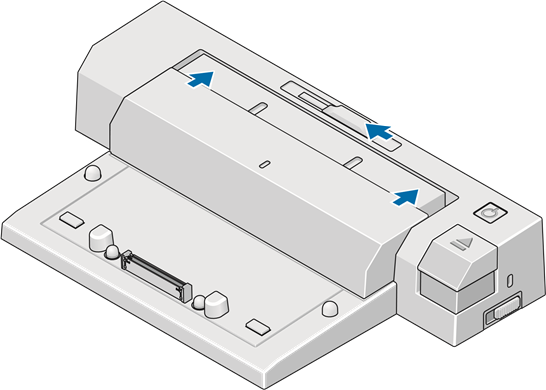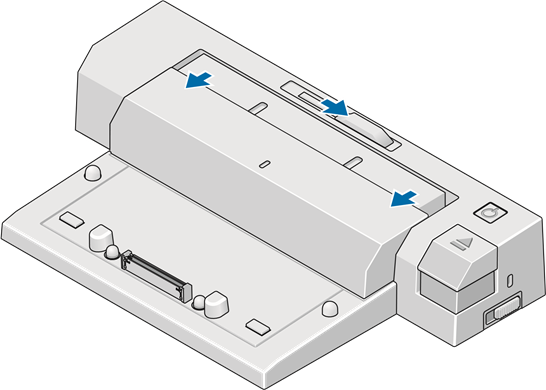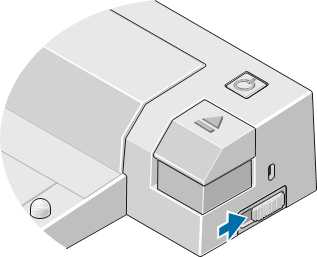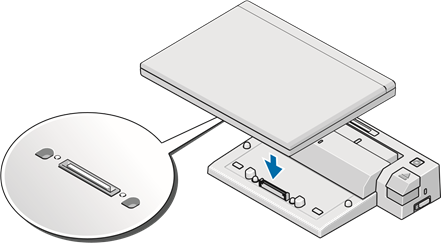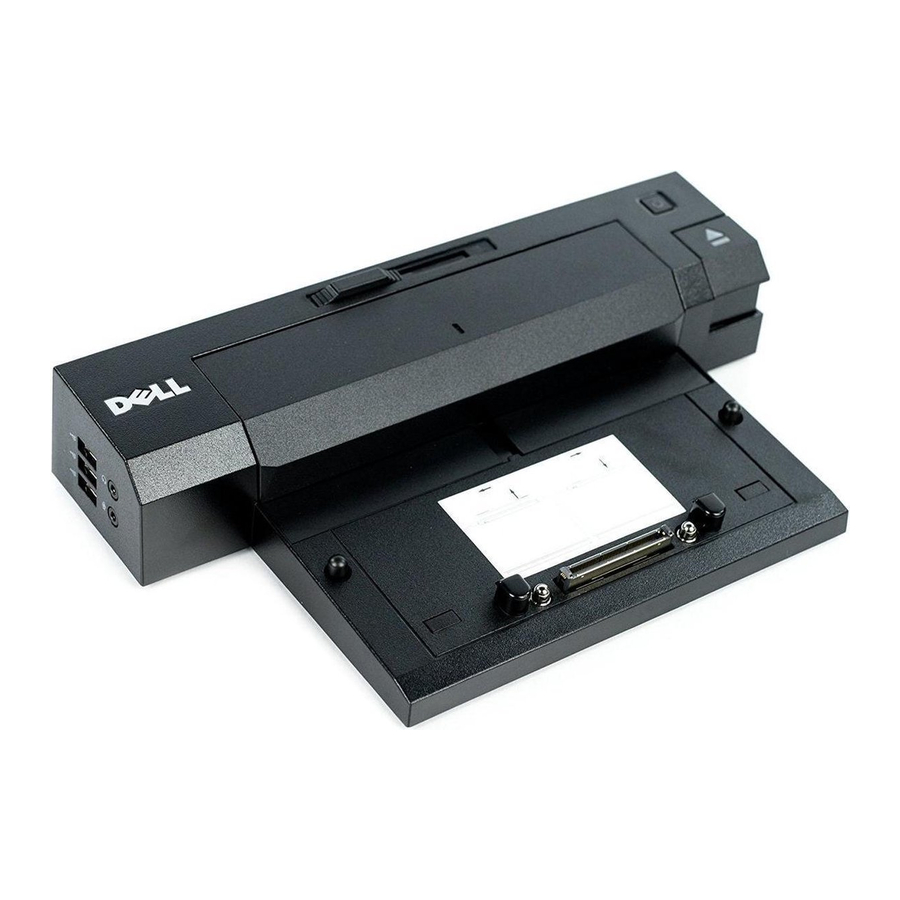
Dell E-Port Plus Docking Station PRO2X Manual
- User manual (24 pages) ,
- Quick setup manual (2 pages) ,
- Setting up (2 pages)

Notes, Notices, and Cautions
![]() NOTE: A NOTE indicates important information that helps you make better use of your computer.
NOTE: A NOTE indicates important information that helps you make better use of your computer.
![]() NOTICE: A NOTICE indicates either potential damage to hardware or loss of data and tells you how to avoid the problem.
NOTICE: A NOTICE indicates either potential damage to hardware or loss of data and tells you how to avoid the problem.
A CAUTION indicates a potential for property damage, personal injury, or death.
About Your Dell™ E-Port Plus
The Dell™ E-Port Plus docking device supports the Dell E-Family laptop computers, but is not compatible with any previous series laptop computers. The E-Port Plus enables you to connect your laptop computer to the following external devices:
| Connector | Description |
 | RJ-45 NETWORK CONNECTOR — Connects a network interface cable. |
 | PARALLEL CONNECTOR — Connects a parallel device such as a printer. |
 | DOCKING CONNECTOR — Connects the laptop to the E - Port Plus docking device. |
 | AUDIO CONNECTORS — Connects audio headphones or speakers and a microphone. |
 | USB 2.0 CONNECTORS — Connect up to five USB 2.0 compliant devices, such as a USB mouse. Three USB connectors are on the left side, and two USB connectors are on the back of the E-Port Plus. |
 | AC ADAPTER CONNECTOR — Connects the AC adapter. |
 | DISPLAYPORT CONNECTOR — Connects external monitors equipped with a DisplayPort interface (also HDMI and DVI monitors via dongle; available at dell.com). |
 | DIGITAL VIDEO INTERFACE (DVI) CONNECTOR — Connects external monitors equipped with a digital video interface. |
 | VGA VIDEO CONNECTOR — Connects an external monitor. |
 | SERIAL CONNECTOR — Connects serial devices, such as a mouse or handheld device. |
 | PS/2 CONNECTORS (2) — Connects PS/2-compatible mouse and keyboard to the E-Port Plus. Shut down the laptop before attaching or removing a PS/2-compatible device. If the device does not work, install the device drivers from the floppy or CD that came with the device, and restart the laptop. |
 | USB OR ESATA CONNECTOR — Connects and supports USB, or Dell powered E-Family or standard selfpowered eSATA devices. |
 | E-MONITOR STAND CONNECTOR — Connects to the E-monitor stand, available at dell.com. |
Overview


Using the Dell™ E-Port Plus
Before you begin any of the procedures in this section, follow the safety instructions that shipped with your computer.
Setting Up Your E-Port Plus
![]() NOTE: If the cable connector of the external device has thumbscrews, tighten the screws to ensure a proper connection.
NOTE: If the cable connector of the external device has thumbscrews, tighten the screws to ensure a proper connection.
If you attach an external monitor to the E-Port Plus, you may need to press
Before You Dock for the First Time
Before you initially connect your laptop to the E-Port Plus, the operating system must complete its setup process. To verify that the operating system has completed the setup process:
Docking Your Laptop
The E-Port Plus can run on its AC power adapter, the laptop's AC power or the laptop's battery. You can use the AC adapter to power the E-Port Plus and the laptop, which charges the battery.
![]() NOTICE: Always use the Dell AC adapter that came with the E-Port Plus. If you use any other commercially available AC adapter, you may damage the E-Port Plus or the laptop.
NOTICE: Always use the Dell AC adapter that came with the E-Port Plus. If you use any other commercially available AC adapter, you may damage the E-Port Plus or the laptop.

- Retract the battery bar if your laptop has a battery that extends beyond the back of the laptop. Slide the battery bar adjuster to the left to retract the battery bar.
![Dell - E-Port Plus - Docking Your Laptop Step 2 Docking Your Laptop Step 2]()
- If your laptop does not have a battery extending from the rear of the laptop body, extend the battery bar by sliding the battery bar adjuster to the right.
![Dell - E-Port Plus - Docking Your Laptop Step 3 Docking Your Laptop Step 3]()
- Push the lock/unlock switch toward the back of the E-Port to unlock it. The E-Port must be unlocked to dock a laptop.
![Dell - E-Port Plus - Docking Your Laptop Step 4 Docking Your Laptop Step 4]()
![]() NOTE: You can dock your laptop regardless of whether it is turned on or off.
NOTE: You can dock your laptop regardless of whether it is turned on or off. - Center the laptop with the E-Port Plus, then push down on the laptop until it clicks into place in the docking connector.
![Dell - E-Port Plus - Docking Your Laptop Step 5 Docking Your Laptop Step 5]()
![]() NOTICE: Do not lift the laptop or the E-Port Plus when the laptop is docked. Doing so can damage the connectors on the laptop and on the E-Port Plus.
NOTICE: Do not lift the laptop or the E-Port Plus when the laptop is docked. Doing so can damage the connectors on the laptop and on the E-Port Plus.
Securing the Dell E-Port Plus
Antitheft devices usually include a segment of metal-stranded cable with an attached locking device and associated key (available at dell.com). For instructions on how to install this kind of antitheft device, see the documentation that came with the device.

The E-Port Plus has the following security features:
LOCK/UNLOCK SWITCH — Move the lock toward the front of the E-Port Plus (locked) to secure a laptop to the E-Port Plus. Move the lock toward the back of the E-Port Plus (unlocked) before pressing the eject button to undock a laptop. The red color in the security cable slot indicates that the E-Port Plus is unlocked.
SECURITY CABLE SLOT — Attach an antitheft device to the E-Port Plus to secure a laptop to the E-Port Plus.
E-Port Plus Laptop Power and Docking Status
The E-Port Plus power button is used to turn a docked laptop on or off. The power button light indicates the power status of the E-Port Plus or a docked laptop. The docking light on the eject button indicates the AC power and docking status of the E-Port Plus and the laptop.
The following table shows all of the possible conditions of docking, power, laptop states and how these conditions are indicated by the E-Port Plus power button and docking lights:
| Power and Docking Status | Laptop Status | Power Button Light | Docking Light |
| Unit undocked or no AC adapter connected | Hibernate or Off | Off | Off |
| Unit docked and AC adapter connected | Hibernate or Off | Off | On |
| Unit docked using AC or battery power | Standby | Breathing | On |
| Unit docked using AC or battery power | On | On | On |
Using the E-Port Plus With Dual Monitors
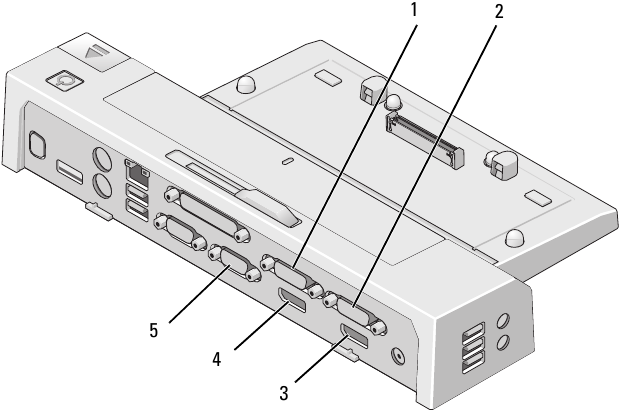
You can use your E-Port Plus for dual monitor display. To enable this feature, connect your monitors using the combinations of connections prescribed below.
| Monitor 1 connection | Monitor 2 connection (works with one of the following) | ||
| video 1 DisplayPort | video 2 DisplayPort | video 2 DVI | VGA |
| video 2 DisplayPort | video 1 DisplayPort | video 1 DVI | VGA |
| video 1 DVI | video 2 DisplayPort | video 2 DVI | VGA |
| video 2 DVI | video 1 DisplayPort | video 1 DVI | VGA |
![]() NOTE: If you connect two video outputs to two monitors from the same video output group at the same time, (i.e., video 1 DisplayPort and video 1 DVI) only the DisplayPort output will be visible.
NOTE: If you connect two video outputs to two monitors from the same video output group at the same time, (i.e., video 1 DisplayPort and video 1 DVI) only the DisplayPort output will be visible.
Undocking Your Laptop

![]() NOTICE: Do not pick up the laptop or the E-Port Plus when the laptop is docked. Doing so can damage the connectors on the laptop and on the E-Port Plus.
NOTICE: Do not pick up the laptop or the E-Port Plus when the laptop is docked. Doing so can damage the connectors on the laptop and on the E-Port Plus.
Specifications
Physical
| Height | 70 mm (2.76 inches) |
| Depth | 180 mm (7.09 inches) |
| Width | 310 mm (12.20 inches) |
I/O Connectors
| Serial (DTE) | one 9-pin connector, 16550-compatible, 16-byte buffer |
| Parallel | one 25-pin unidirectional, bidirectional, or ECP connector |
| PS/2 | two 6-pin mini-DIN connectors |
| USB | Six USB connectors: five 4-pin, USB 2.0-compliant connectors, one USB or eSATA connector |
| Audio | headphones/speakers and microphone |
| Network | one RJ-45 port; 10/100/1000 GB Ethernet |
| Dell™ E-Family docking connector | one custom connector (Dell E-Family only) |
| Video 1 | VGA, DVI, DisplayPort (HDMI via dongle) |
| Video 2 | DVI and DisplayPort (HDMI via dongle) |
| USB or eSATA connector | one connector supporting USB or Dell powered E-Family or standard selfpowered eSATA devices |
| E-Monitor Stand connector | one custom connector (Dell E-Family only) |
AC Adapter Power
| Input Voltage | Wattage | Amperage |
| 100–240 VAC, 50–60 Hz | 130W* | 1.8A |
| 100–240 VAC, 50–60 Hz | 210W* | 3.2A |
*A laptop with a screen size of greater than 15.4" requires using the 210W AC adapter
System Level Operational Specifications
| Variable | Minimum | Typical | Maximum |
| Temperature (system external) | 0°C | 25°C | 35°C |
| Temperature ramp rate | 0°C/hr | N/A | 10°C/hr |
| Humidity (non-condensing) | 10% | N/A | 80% |
| Humidity ramp rate | 20% / hr | ||
| Altitude | 0 m (0 ft) | 3048 m (10,000 ft) |
System Level Non-Operational and Shipping Specifications
| Variable | Minimum | Maximum |
| Temperature | –40°C | 65°C |
| Temperature ramp rate | 0°C/hr | 20°C/hr |
| Humidity (non-condensing) | 5% | 95% |
| Humidity ramp rate | N/A | 20% / hr |
| Altitude | 0 m (0 ft) | 10,670 m (35,000 ft) |
Finding Information
| Documents | Contents |
| Safety, Regulatory, Warranty, and Support Documentation This type of information may have shipped with your computer. For additional regulatory information, see the Regulatory Compliance Homepage on www.dell.com at the following location: www.dell.com/regulatory_compliance. | |
Glossary
A
AC — alternating current — The form of electricity that powers your computer when you plug the AC adapter power cable in to an electrical outlet.
D
DisplayPort— An interface standard of the Video Electronics Standards Association (VESA) used for digital displays.
Docking device — Provides port replication, cable management, and security features to adapt your laptop to a desktop workspace.
DVI— digital video interface — A standard for digital transmission between a computer and a digital video display.
E
eSATA— External Serial Advanced Technology Attachment — An interface for external Serial ATA devices.
H
HDMI— High-Definition Multimedia Interface — An interface of 19 separate, uncompressed audio and video signals used for high definition TV and audio.
I
I/O— input/output — An operation or device that enters and extracts data from your computer. Keyboards and printers are I/O devices.
P
Parallel connector — An I/O port often used to connect a parallel printer to your computer. Also referred to as an LPT port.
PS/2— personal system/2 — A type of connector for attaching a PS/2-compatible keyboard, mouse, or keypad.
S
SATA— serial ATA — A faster, serial version of the ATA (IDE) interface.
Serial connector — An I/O port often used to connect devices such as a handheld digital device or digital camera to your computer.
U
USB — universal serial bus — A hardware interface for a low-speed device such as a USB-compatible keyboard, mouse, joystick, scanner, set of speakers, printer, broadband devices (DSL and cable modems), imaging devices, or storage devices. Devices are plugged directly in to a 4-pin socket on your computer or in to a multi-port hub that plugs in to your computer. USB devices can be connected and disconnected while the computer is turned on, and they can also be daisy-chained together.
Information in this document is subject to change without notice. © 2008 Dell Inc. All rights reserved.
Reproduction in any manner whatsoever without the written permission of Dell Inc. is strictly forbidden.
Trademarks used in this text: Dell and the DELL logo are trademarks of Dell Inc.
Other trademarks and trade names may be used in this document to refer to either the entities claiming the marks and names or their products. Dell Inc. disclaims any proprietary interest in trademarks and trade names other than its own.
www.dell.com | support.dell.com
Documents / Resources
References
Computers, Monitors & Technology Solutions | Dell USA
Regulatory Compliance | Dell
Computers, Monitors & Technology Solutions | Dell USA
Computers, Monitors & Technology Solutions | Dell USA
Download manual
Here you can download full pdf version of manual, it may contain additional safety instructions, warranty information, FCC rules, etc.

